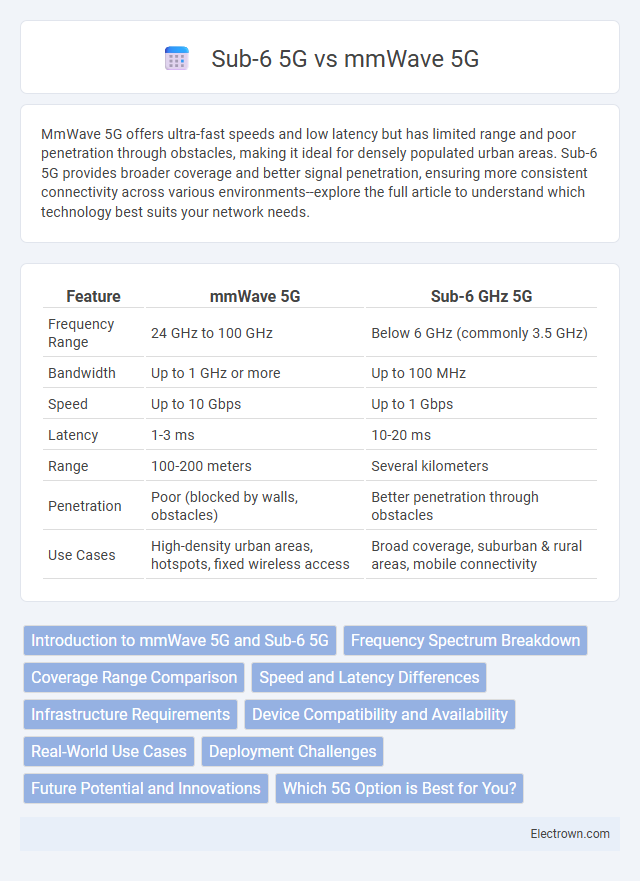MmWave 5G offers ultra-fast speeds and low latency but has limited range and poor penetration through obstacles, making it ideal for densely populated urban areas. Sub-6 5G provides broader coverage and better signal penetration, ensuring more consistent connectivity across various environments--explore the full article to understand which technology best suits your network needs.
Table of Comparison
| Feature | mmWave 5G | Sub-6 GHz 5G |
|---|---|---|
| Frequency Range | 24 GHz to 100 GHz | Below 6 GHz (commonly 3.5 GHz) |
| Bandwidth | Up to 1 GHz or more | Up to 100 MHz |
| Speed | Up to 10 Gbps | Up to 1 Gbps |
| Latency | 1-3 ms | 10-20 ms |
| Range | 100-200 meters | Several kilometers |
| Penetration | Poor (blocked by walls, obstacles) | Better penetration through obstacles |
| Use Cases | High-density urban areas, hotspots, fixed wireless access | Broad coverage, suburban & rural areas, mobile connectivity |
Introduction to mmWave 5G and Sub-6 5G
mmWave 5G operates in high-frequency bands above 24 GHz, offering ultra-fast data speeds and low latency ideal for densely populated urban areas and high-capacity use cases. Sub-6 5G uses frequencies below 6 GHz, providing broader coverage and better penetration through obstacles, making it suitable for wide-area and rural deployments. Both technologies complement each other to deliver a balance of speed and coverage in 5G networks.
Frequency Spectrum Breakdown
mmWave 5G operates within the 24 GHz to 100 GHz frequency spectrum, offering ultra-high speeds and low latency but limited range and penetration capabilities. Sub-6 5G covers frequencies below 6 GHz, typically between 600 MHz and 6 GHz, providing broader coverage and better indoor penetration while delivering moderate speed improvements over LTE. The spectrum allocation impacts network deployment strategies, with mmWave suited for dense urban environments and Sub-6 ideal for widespread rural and suburban coverage.
Coverage Range Comparison
mmWave 5G operates at higher frequencies, typically between 24 GHz and 100 GHz, offering ultra-fast data rates but limited coverage range and lower penetration through obstacles like walls. In contrast, Sub-6 5G uses frequencies below 6 GHz, providing broader coverage, better indoor penetration, and more consistent signal strength across larger areas. Understanding these differences helps you choose the best 5G technology based on your coverage needs and environment.
Speed and Latency Differences
mmWave 5G delivers ultra-fast speeds reaching up to 10 Gbps with ultra-low latency around 1 millisecond, ideal for applications requiring rapid data transfer and real-time responsiveness. Sub-6 5G provides broader coverage with speeds typically up to 1 Gbps and slightly higher latency between 10 to 20 milliseconds, balancing performance and range. Your choice depends on whether high-speed, low-latency connections or wider network availability is more critical for your needs.
Infrastructure Requirements
mmWave 5G requires dense infrastructure with a high number of small cells due to its limited range and susceptibility to obstruction, demanding more frequent base station deployment and advanced beamforming technologies. Sub-6 5G operates on lower frequencies, allowing greater coverage with fewer base stations, reducing infrastructure costs and complexity. Both technologies require fiber backhaul for high bandwidth, but mmWave's infrastructure investment is significantly higher because of its need for proximity and line-of-sight conditions.
Device Compatibility and Availability
mmWave 5G offers ultra-high-speed connectivity but requires specialized hardware, limiting device compatibility to flagship smartphones and select industrial equipment. Sub-6 5G supports a broader range of devices from mid-tier to flagship models due to its lower frequency bands and wider coverage. Sub-6's extensive availability across regions enhances user adoption and device diversity compared to mmWave's limited network presence.
Real-World Use Cases
mmWave 5G offers ultra-high-speed connectivity ideal for dense urban environments, stadiums, and augmented reality applications requiring extremely low latency and massive data throughput. Sub-6 5G provides broader coverage and better penetration through obstacles, making it suitable for rural areas, smart cities, and IoT deployments where stable, widespread connectivity is essential. Enterprises often combine both bands to leverage mmWave's speed for localized high-demand scenarios while relying on Sub-6 for consistent, expansive network access.
Deployment Challenges
mmWave 5G faces significant deployment challenges due to its limited range and poor penetration through buildings, requiring dense networks of small cells and extensive infrastructure investments. In contrast, Sub-6 5G offers broader coverage with better signal propagation, reducing the need for frequent cell installations but often delivering lower peak speeds compared to mmWave. Both technologies necessitate careful planning to balance coverage, capacity, and cost in diverse urban and rural environments.
Future Potential and Innovations
mmWave 5G offers ultra-high bandwidth and extremely low latency, enabling innovations in augmented reality, autonomous vehicles, and smart cities with its capability to support massive data throughput in dense urban areas. Sub-6 GHz 5G provides broader coverage and better penetration, making it essential for widespread 5G adoption and enabling advancements in IoT applications, remote healthcare, and rural connectivity. Future potential lies in hybrid networks combining mmWave's speed with Sub-6's coverage to deliver seamless, high-performance 5G experiences across diverse environments.
Which 5G Option is Best for You?
Choosing between mmWave 5G and Sub-6 5G depends on your specific needs: mmWave 5G offers ultra-high speeds above 1 Gbps with low latency, ideal for dense urban areas and applications like real-time gaming or augmented reality. Sub-6 5G provides broader coverage and better penetration through walls, supporting speeds around 100-400 Mbps, making it suitable for suburban and rural areas where consistent connectivity is essential. Evaluating factors such as location, usage patterns, and device compatibility will help determine the optimal 5G option for reliable performance.
mmWave 5G vs Sub-6 5G Infographic

 electrown.com
electrown.com